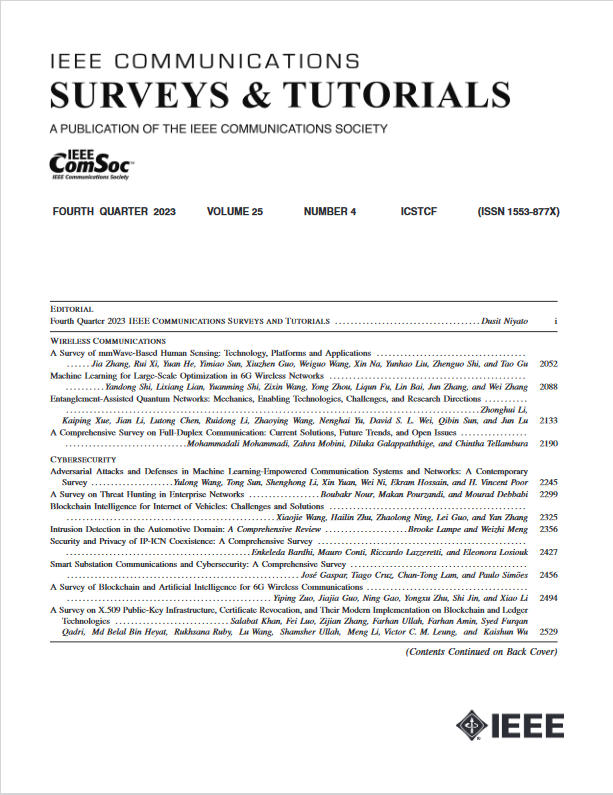光通信如何塑造深空通信的未来?调查
IF 34.4
1区 计算机科学
Q1 COMPUTER SCIENCE, INFORMATION SYSTEMS
引用次数: 0
摘要
由于预计到本十年末将有大量的深空(DS)任务,因此比以往任何时候都更需要可靠和高容量的深空通信。然而,现有的技术还远远达不到这一目标。改进现有系统不仅需要工程领导,而且非常关键的是,研究克服超长DS链路独特挑战的潜在技术。据我们所知,在过去的十年里,没有任何关于DS通信技术的全面调查。自由空间光学(FSO)是一种新兴的DS技术,与目前使用的对应射频(RF)相比,已被证明可以获得更低的通信系统尺寸、重量和功率(SWaP),并实现非常高的容量。在本文中,我们讨论了深空光通信(DSOC)的优缺点,并回顾了它们的物理和网络特性。此外,我们还首次对轨道角动量(OAM)和量子通信(QC)在DS中的实现进行了深入的讨论。我们详细阐述了这些技术如何与其他领域的进步,包括行星际网络(IPN)和射频/FSO系统,提高可靠性,容量和安全性。本文对DSOC技术进行了全面的调查,收集了247篇零散的文献,包括新的观点,旨在为该领域的更多发展奠定基础。本文章由计算机程序翻译,如有差异,请以英文原文为准。
How Can Optical Communications Shape the Future of Deep Space Communications? A Survey
With a large number of deep space (DS) missions anticipated by the end of this decade, reliable and high-capacity DS communications are needed more than ever. Nevertheless, existing technologies are far from meeting such a goal. Improving current systems does not only require engineering leadership, but also, very crucially, investigating potential technologies that overcome the unique challenges of ultra-long DS links. To the best of our knowledge, there has not been any comprehensive surveys of DS communications technologies over the last decade. Free space optical (FSO) is an emerging DS technology, proven to acquire lower communications systems size weight and power (SWaP) and achieve a very high capacity compared to its counterpart radio frequency (RF), the currently used DS technology. In this survey, we discuss the pros and cons of deep space optical communications (DSOC) and review their physical and networking characteristics. Furthermore, we provide, for the first time, thoughtful discussions about implementing orbital angular momentum (OAM) and quantum communications (QC) for DS. We elaborate on how these technologies among other field advances including interplanetary network (IPN) and RF/FSO systems improve reliability, capacity, and security. This paper provides a holistic survey of DSOC technologies gathering 247 fragmented pieces of literature and including novel perspectives aiming to set the stage for more developments in the field.
求助全文
通过发布文献求助,成功后即可免费获取论文全文。
去求助
来源期刊

IEEE Communications Surveys and Tutorials
COMPUTER SCIENCE, INFORMATION SYSTEMS-TELECOMMUNICATIONS
CiteScore
80.20
自引率
2.50%
发文量
84
审稿时长
6 months
期刊介绍:
IEEE Communications Surveys & Tutorials is an online journal published by the IEEE Communications Society for tutorials and surveys covering all aspects of the communications field. Telecommunications technology is progressing at a rapid pace, and the IEEE Communications Society is committed to providing researchers and other professionals the information and tools to stay abreast. IEEE Communications Surveys and Tutorials focuses on integrating and adding understanding to the existing literature on communications, putting results in context. Whether searching for in-depth information about a familiar area or an introduction into a new area, IEEE Communications Surveys & Tutorials aims to be the premier source of peer-reviewed, comprehensive tutorials and surveys, and pointers to further sources. IEEE Communications Surveys & Tutorials publishes only articles exclusively written for IEEE Communications Surveys & Tutorials and go through a rigorous review process before their publication in the quarterly issues.
A tutorial article in the IEEE Communications Surveys & Tutorials should be designed to help the reader to become familiar with and learn something specific about a chosen topic. In contrast, the term survey, as applied here, is defined to mean a survey of the literature. A survey article in IEEE Communications Surveys & Tutorials should provide a comprehensive review of developments in a selected area, covering its development from its inception to its current state and beyond, and illustrating its development through liberal citations from the literature. Both tutorials and surveys should be tutorial in nature and should be written in a style comprehensible to readers outside the specialty of the article.
 求助内容:
求助内容: 应助结果提醒方式:
应助结果提醒方式:


